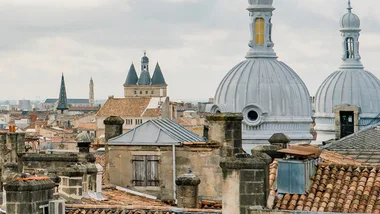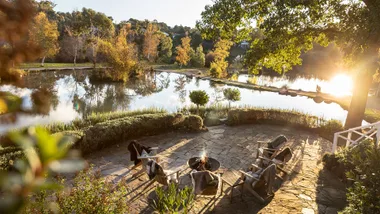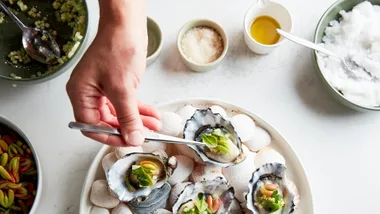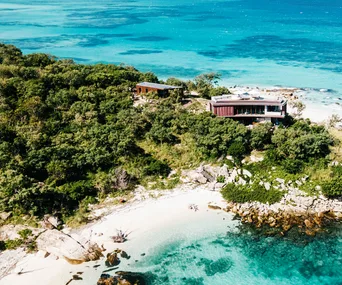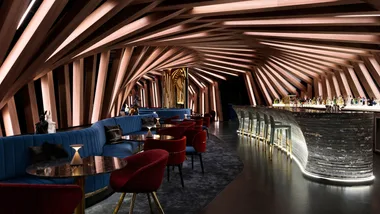In the pit below the gold-embroidered theatre scrim emblazoned with a double-headed imperial Russian eagle, the orchestra is warming up on a chilly autumn evening in Saint Petersburg. Their brows furrowed, they test and tune their instruments with the kind of intense concentration I recall in the characters of Dostoyevsky, Tolstoy and Turgenev, the leading lights of the famously intense Russian canon that I laboured through many years ago at university.
In a different way, I’m limbering up, too, since this is the first night of a highly anticipated journey by ship into the heart of Russia. I’ve long been curious about life in the world’s largest nation, but also humbled by the scale of this Slavic enigma. I owe my grail to the 18th-century Romantic poet Lord Byron, who wrote: “Admittedly there are other ways of making the world’s acquaintance. But the traveller is a slave to his senses; his grasp of a fact can only be complete when reinforced by sensory evidence; he can know the world, in fact, only when he sees, hears, and smells it.”

Pavilion Hall of the Small Hermitage, Winter Palace, Saint Petersburg
Despite the dulling scents of damp wool and wet leather in the overheated air, there’s an aura of collective wonderment in the audience, comprised mainly of my fellow passengers aboard the Viking Ingvar. “I still can’t believe I’m actually sitting here, in Russia,” whispers the woman next to me. “When I was a girl in grade school in Massachusetts, we had air-raid drills to practise hiding under our desks if there was a Russian missile attack. I doubt our desks would have saved us, but it stamped our young minds with ideas about the Soviet Union.” She shrugs, “I guess you could call that propaganda.”
We’re in the lavishly gilded private theatre of Catherine the Great in the Hermitage Museum, which also houses her 18th-century Winter Palace. Now the conductor arrives, and bows to the audience. He raises his arms, holding them aloft just a second or two longer than anyone expects to insist on silence, and the performance by the Saint Petersburg State Governor’s Symphony begins. The exquisitely doleful opening notes of Tchaikovsky’s Swan Lake draw to the stage a cast of long-limbed dancers in white tutus from the theatre’s own company, and we watch as the story of doomed love unfolds between Prince Siegfried and Odette, the swan maiden. I think of it as a profoundly Russian tale, because embedded in the ballet’s tragic story is an implicit celebration of the Slavic soul, the cardinal points of which are pride, perseverance and discipline.
And so, as often happens at the beginning of a great trip, I find the wick of my journey – the chance it will offer to fathom the uniquely intense and complex Russian character.

Moskva river and the Kremlin, Moscow
Peter the Great built his magnificent Saint Petersburg in the 18th century, on the marshy delta of the Neva river where it empties into the Baltic Sea, to be Russia’s window on the West. Our 13-day cruise will take us deep into the countryside and then to Moscow, the citadel of Russian power and pride. There’s a refrain of discovery on the journey between these two cities as we match reality to places we’ve only ever seen on maps or read about. We’re all surprised by the enormousness of Lake Ladoga, for example, and later by the similarly unexpected beauty of the 11th-century city of Yaroslavl, built on a bluff overlooking the Volga.

Bayan player, Moscow
Since the allure of a trip to Russia is decidedly cerebral compared with that of Mediterranean destinations, Viking River Cruises arranges tours and lectures tailored for a well-informed and intellectually curious audience during our four days in Saint Petersburg. There’s a private-access visit to the Hermitage, one of the world’s great art museums, and I join an excursion to the Catherine Palace in Pushkin, a daytrip south of Saint Petersburg, with its Amber Room rightly described as the “eighth wonder of the world”. On a sunny afternoon, a daytrip to Peterhof Palace, the country estate founded by Peter the Great in 1709 on the shore of the Baltic Sea, is dazzling; its gravity-powered Grand Cascade and Samson Fountain were inspired by those at King Louis XIV’s Château de Marly. But almost more compelling than these splendid encounters with imperial grandeur are the intimate glimpses of modern Russian reality that we get during a range of encounters and home visits.

Saint Basil’s Cathedral, Moscow
On a dove-grey Sunday afternoon I join a small group of fellow passengers for tea at the home of Larisa Baltrukova in a kommunalka – a communally organised block of flats – in a tidy residential district of central Saint Petersburg composed of late-19th-century apartment buildings with wedding-cake façades. A plaque by the main entrance says the building was nationalised in 1917 under Lenin, who created this socialist-style living as a way of accommodating the city’s rapidly growing population during a time of acute housing shortages.
Thin light filters through lace curtains at the three tall windows in Baltrukova’s living room as she fills teacups and serves cakes – one filled with sweet curd cheese, another with minced meat and onions – from Stolle, one of the best-known bakeries in the city. Through an interpreter, she says she’s a trained nurse and the widow of an admiral in the navy, and she lived in Vladivostock in the Russian far east for many years. Twelve years ago she bought her flat, with its shared kitchen and bathroom, for the equivalent of $US27,000.

Church of the Saviour on Spilled Blood, Saint Petersburg
“How is life in Russia today – better or worse than it was during the days of the Soviet Union?” asks a woman from London. The sixty-something Baltrukova smiles briefly and cocks her head. “Life was more civil, stable and better organised during the Soviet times, especially the Brezhnev years. People were better disciplined and thought of the well-being of their community rather than just their own needs and desires,” she says, deftly exposing the ambient nostalgia for the Soviet Union that fuels the popularity of President Vladimir Putin.
“But what of your young grandson, who never knew the Soviet Union?”
“He loves the Western pop stars, but I worry for his future,” she says. “He cannot find a job doing the medical technician work he trained for, so he will have to settle for something that pays less well.”
On the way back to the ship, our guide circumspectly echoes our host’s assessment of Russia’s foreign policy. “We want to be friends with every country, but Putin had no choice but to try and restore Russia to its rightful place in the world,” he says gravely, adding, “and it was wrong of you to take parts of our country into NATO.” There’s often a frisson in conversations during this journey – a pervasive assumption of being misunderstood and a polite insistence that visitors try to appreciate the point of view of Russians. (A young guide even says cheerfully one day, “Enjoy your trip to Russia, ladies and gentlemen. And remember, we will be nice to you, if you will be nice to us.”)

A girl paints matryoshka dolls in Uglich
I wondered if the kitchen and bars on board the Ingvar would be affected by the draconian import bans and restrictions Russia has imposed on many European foods and wines in retaliation for the economic sanctions imposed on the country after it annexed Crimea in 2014. “Yes, the sanctions have made supplying the ship more complicated and expensive,” says Daniel, the unfailingly gracious maître d’hotel, when I ask. “But we’ve also discovered many more good Russian products than we used before. So the silver lining is perhaps a greater authenticity.”
Rather than the bland international menu I feared, the daily offer is largely Russian. Dishes such as rassolnik, often made with giblets and pickles, but which appears here as a rich chicken soup, are regular features; as well as pelmeni, little meat-filled dumplings that are a Siberian specialty; and Pozharsky cutlets, meat or fish rissoles encased in crisp bread cubes.

Pelmeni with pickles, cabbage, slaw and beef stew on board the Viking Ingvar.
The wines, too, are a highlight. There’s an extensive list of Russian and Georgian wines, and a range of food-and-drink experiences, including a pelmeni-making demonstration and a very professional vodka tasting; the crowd-pleaser here is Mamont from a Siberian distillery founded in 1868. The most memorable, however, is a wine tasting led by Daniel, who’s also the ship’s sommelier. Afterwards, I order the two wines that were standouts in his flight of six: a Monte Garu sparkling wine from the Krasnodar region of Russia that first won a gold medal at the 1900 Universal Exposition in Paris, and a fascinating Georgian wine, Tbilvino Qvevris Rkatsiteli, that surprised with a Sauternes-like nose but pleasantly maderised taste.
Just before dusk we leave Saint Petersburg and churn upstream through the pewter-coloured waters of the Neva. I’m glad of a quiet afternoon on the balcony of my Veranda suite, a well-designed space with a Scandinavian look created by neutrals and blond-wood fittings. For many kilometres the beech and birch trees lining the riverbanks present a cook’s palette of autumnal colours – tea, cinnamon, caramel, lemon and apple red – only occasionally interrupted by the rusty docks and locks of country that often looks worn and dated as soon as you leave its cities.

Birch trees along the Neva River
Almost everyone, even those who think they know European geography well, is surprised to discover that Lake Onega is so huge you often can’t see its shores during our passage to Kizhi, an island bound by marshes and covered by emerald fields, to see the wooden Churches of the Transfiguration and the Intercession, a UNESCO World Heritage site.
Seen from afar, the silvery wooden domes of the churches are both stirring and spectacular; they get their metallic appearance from the weathering of their hand-hewn aspen shingles. Built from thousands of logs transported to the island from the mainland, the churches were constructed without nails, using dovetail joinery instead. A third structure, the 14th-century Church of the Resurrection of Lazarus, stuns with the power of the 17 icons that comprise its iconostasis.

Church spires in the Kizhl Pogost, Kizhl
Nearby, in an old farmhouse, we learn a little of life on the island, once inhabited by several thousand, today home to only a handful of custodians. Its single large room worked as a sort of machine for living, since the huge brick stove occupying a third of the space provided light and heat. “It was built off the floor so that chickens could live underneath it in the winter and continue to supply the family with eggs,” says our guide. “When it was very cold – winter here usually begins in October and runs through to May – it was the privilege of the elderly and children to sleep on top of the stove.” This meant that the family of 10 living here in the late 1600s spent eight months in a single room on a tiny island in the middle of a lake where it was often minus 30 degrees. Then, when spring came, they eked out a living fishing the lake or coaxing meagre crops of rye from poor soil. “And of course most people lived this way in northern Russia less than a century ago,” we’re reminded. “You made or grew almost everything you ate, wore or needed.”
This kind of sinewy ancestral memory helps to inform the recurring subtext of the bemused remarks and well-polished jokes of Russian staff and residents we meet. I recall an exchange with a cab driver in Saint Petersburg a few days earlier. He lived in Toronto for six years and returned to Russia because of his disaffection with “nonstop consumerism”, causing people to buy things they don’t need and can’t afford. “It also happens because your educational systems produce so many idiots.” Staring hard at me in the rear-view mirror at a traffic light, he seemed disappointed when his pugnacious statements elicited nothing more than sympathetic nods from me. So he tried again, “Unlike you, we Russians are proud to remain a deeply serious people.” He looked devastated when I agreed. “Yes, you Russians are a very serious people,” I replied, “and it’s quite refreshing.” I meant it, too.
In contrast to the sunny optimism of the relatively newborn colonial countries of America, Australia and Canada, Russians are a reflexively pessimistic people. It makes sense to brace yourself for disappointment when almost everything that surrounds you is a regular reminder that life is hard, arbitrary and frequently unfair. Making peace with this reality engenders a wry sense of humour that dulls the resignation necessary to stay sane in the face of circumstances you’re usually powerless to change, too. And so the ironical wit and truculent pride of the Russians in their country and culture have become the quiet backdrop of our trip.

Ceiling of the Church of Saint Dimitry on the Blood, Uglich
As the days pass, the Ingvar becomes an amiable village where life is animated by reflexive pleasantries, meals and a full schedule. Tribes emerge, of course, with some of the ship’s 200 passengers preferring to relax in their cabins, others in the lounges, where lectures and Russian language lessons are held.
Our last stop before Moscow is Uglich, a handsome old town on the banks of the Volga. Like Yaroslavl, it’s part of the Golden Ring, the constellation of historic towns north of Moscow, and known for an ornate wall of icons in its green-domed cathedral of the Transfiguration of Our Saviour and for the rather lurid frescoes in the Church of Saint Dimitry on the Blood that memorialise the death of Ivan the Terrible’s son. Today, the town is looking for a future from tourism, since its main industry – watch-making – has been buffeted to near extinction by the demise of the Soviet Union and the use of mobile phones as timepieces. Still, watch stores selling the local Chaika line the main street – the brand’s name originates from the call signal of Valentina Tereshkova, Russia’s first female astronaut. Their owners occasionally tout their wares. “Great gift, great souvenir, so camp! No?” says a middle-aged woman as we head for the bus on our way to a home visit.

Tamara and her husband Nikolai
We’re ushered into the dining room of a sturdy red-headed woman with ice-blue eyes who asks us to call her Tamara. A large photo mural of downtown Chicago covering one wall prompts a giggle from guests; “I chose it to make tourists feel at home,” Tamara says with a bemused smile. We try the home-distilled vodka made by her husband, Nikolai, with yeast, water and sugar – a real 45-proof eye-opener at 10am – accompanied by black bread, a salad of dill-flecked, home-grown potatoes, and tangy pickles: half-sour and sweet-and-sour gherkins and wild mushrooms. Doubtless abetted by Nikolai’s potent tipple, high spirits prevail during an exchange of questions.
“So what do you think of Putin?” ventures a retired stockbroker from San Francisco. Tamara shrugs theatrically. “Ouf, I don’t know. Maybe some of the same things you think of your Trump,” she replies, with the satisfaction of having thrown a polite but well-aimed dart.
“Touché! They do rather seem to get along, don’t they?” says the quick-witted San Franciscan.

Matryoshka dolls in Uglich
The pickles came from her well-stocked root cellar, beneath a trapdoor in her living room. Our host shows us, shining a torch into the darkness, revealing rows of preserves made from the produce of her kitchen garden behind the banya, or sauna cabin. “A kitchen garden is the best insurance policy you can have in Russia,” says Tamara’s friend, Galina, who’s our interpreter, “because whatever happens, you’ll always have enough to eat.” On the eve of winter, a cold frame in the garden is still filled with cucumber vines trained on trellises and chillies producing the last harvest of the season.
Just before we reach Moscow, a Cuban friend who lives in the Russian capital spots my Instagram feed and messages to ask if I’m free for lunch at Beluga, a recently opened restaurant in the Hotel National on the edge of the Kremlin. So the next morning, I’m a little bewildered by the Moscow metro after being under someone else’s wing for 10 days. Twenty-five minutes later, I arrive at a beautiful dining room with a Baccarat glass bar and tables dressed in snowy linens.

Beluga restaurant
A sullen waitress leads me to the table where Armando, whom I haven’t seen in many years, is pecking away on his phone. As befits the manager of the Moscow boutique of a major Italian fashion designer, he looks so smart that I can’t help but feel hopelessly dumpy in my saggy jumper, windbreaker, khaki trousers and deck shoes, the signature outfit of most male passengers aboard the Ingvar.
He eyeballs me appraisingly but kindly, and says, “I’m going to make it better, my friend.” And he does, when the waiter responds to his fluent Russian by bringing us a feast for a tsar: oscietra grey caviar with blini; Baltic herring tartare with marinated onions; grilled artichokes with pressed sturgeon caviar; salt-baked sturgeon with Abkhaz lemons and thyme; smoked pike with mushroom sauce, shallot confit and fried mushrooms – and there might have been more if I hadn’t begged him to stop. The thing is, I explain to Armando, the Russian dish I knew I’d end up braving soon after returning home is shchi, the famously homey, slightly sour cabbage soup served with a big dollop of smetana, sour cream. I’d eaten a bowl of it in a hole-in-the-wall café the day I’d arrived in Saint Petersburg.
Armando raises his dark brows. “Seriously? Why?”
I doubt he’ll understand, but after my trip through the heart of Russia, I couldn’t think of a single dish that better expresses this great Slavic nation’s endearing humility, ingenuity and tenacity, along with its appetisingly piquant perspective on life. To boot, it’s cheap, and it’s good for you. I knew I’d miss Russia.
Getting there
Emirates and Qatar Airways fly to Saint Petersburg and Moscow, the arrival and departure ports for Viking’s Russia river cruises, from select Australian cities.
Russian cruises
Viking River Cruises’ 13-day Waterways of the Tsars cruise from Saint Petersburg to Moscow, and in reverse, operates May to October 2018 and 2019. It costs from $7,895 per person twin share, which includes return flights from select Australian cities to Russia, accommodation, all meals, wine and beer with lunch and dinner, one excursion in every port and onboard activities. 138 747, vikingrivercruises.com.au

